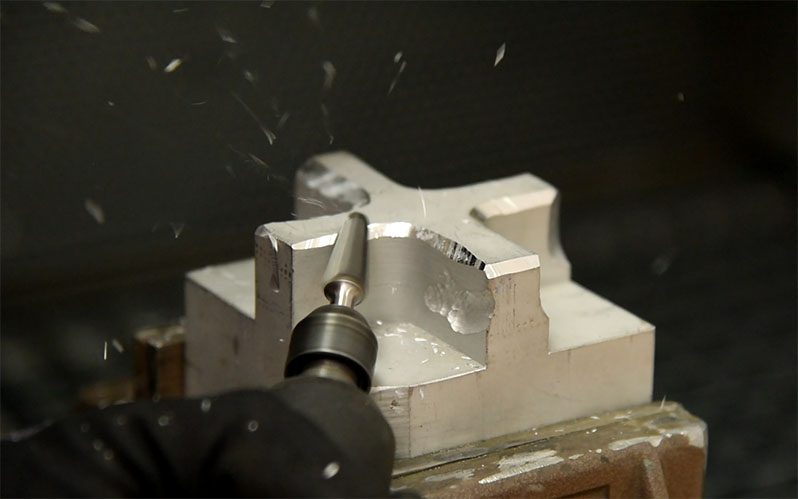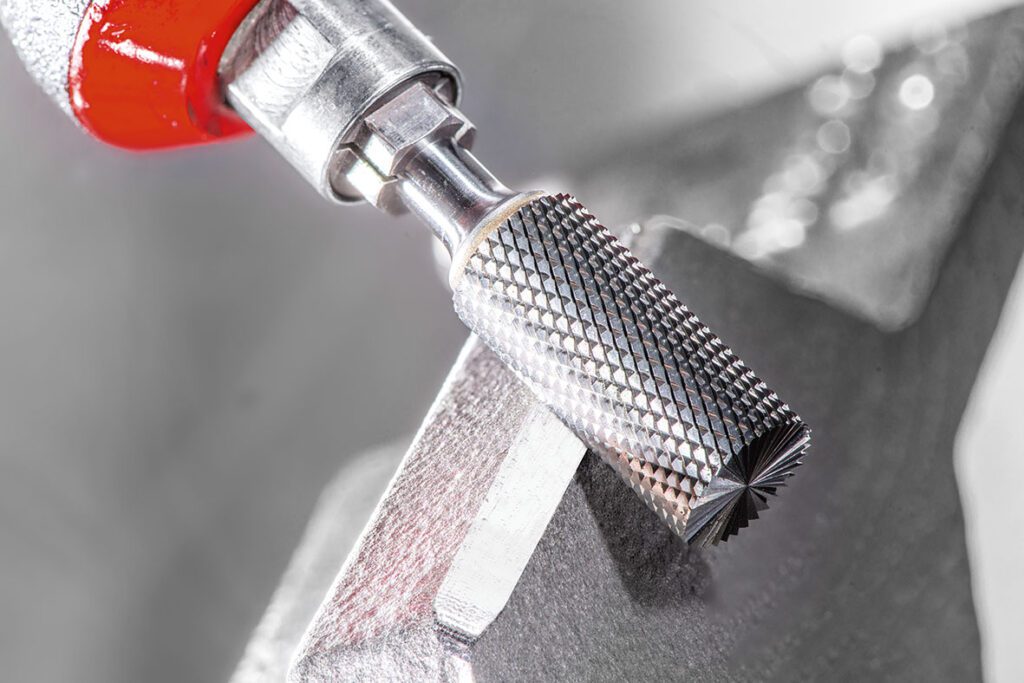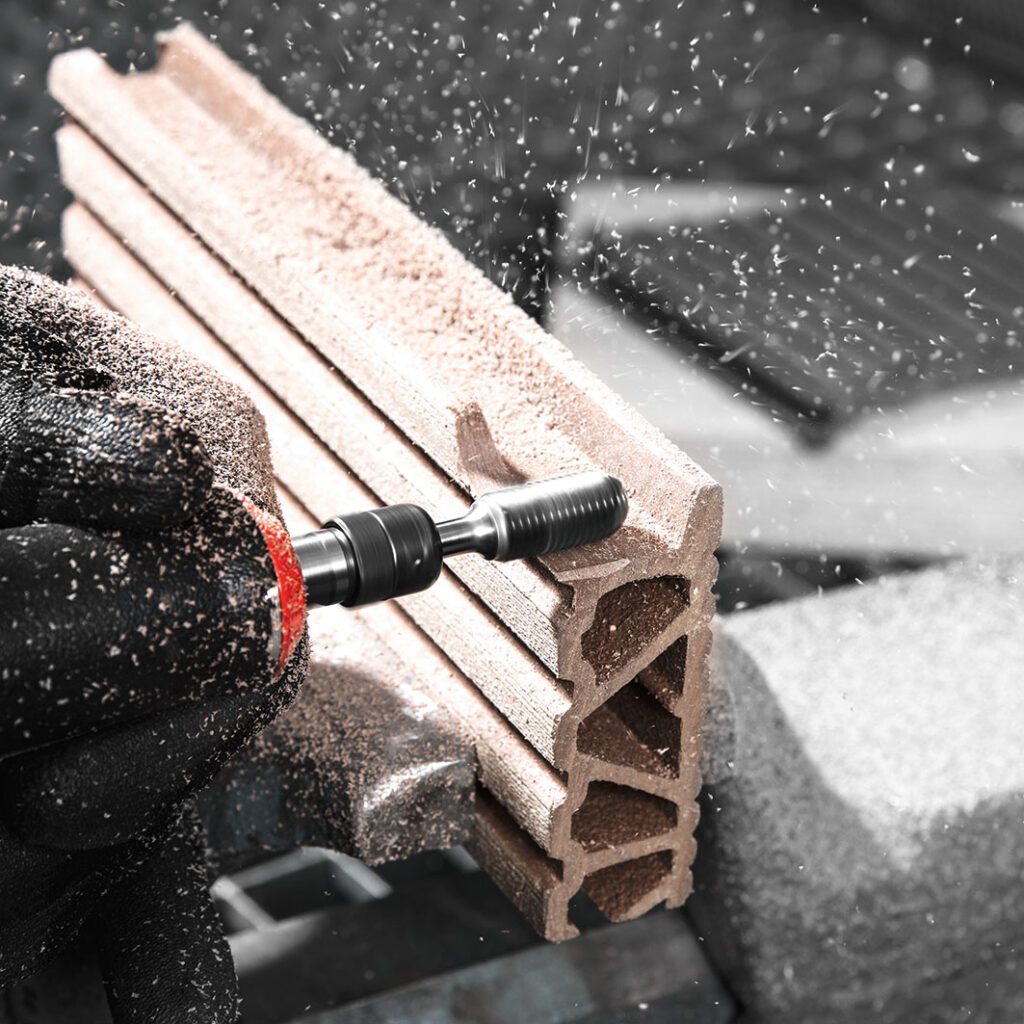Fault prevention when cutting: typical milling faults and their solutions
Alongside many other influencing factors, precise milling processes also determine production quality and efficiency in the metalworking industry. Even small faults such as incorrect speeds or excessive applied grinding pressure can have serious consequences when milling material. Some typical sources of faults when cutting materials and their practical solutions are described below to sensitise everyone concerned with this important topic to support optimum process reliability – and in doing so help to permanently achieve a high surface quality during milling and to extend the tool life. One basic requirement is to use high-quality tools such as those offered to its customers by LUKAS-ERZETT.
The ideal case: when the operator, tool and machine work together perfectly.
Precision is frequently the be-all and end-all when cutting metal – and this can only be achieved through the smooth interaction of the operator, machine and tool. Even the slightest deviation in the cutting conditions or small operating errors can have major consequences: the quality of the machined surface diminishes, the tool wears out more quickly and, in the worst case, production delays or rejects occur. Vibrations during the milling process are a common cause. These arise, for example, as the result of unstable clamping, incorrect cutting speeds or unsuitable tool guidance. This means that the tool does not cut continuously, but “plucks” or “tears” the material. Rough, irregular surfaces are the result. Advanced tool wear, excessive applied grinding pressure, incorrect milling tools and unsuitable toothing grades also impair the milling quality. But – and this is the good news – many problems can be avoided from the outset with the right choice of tool, optimum speed settings, the correct feed rate and conscious consideration of the process. And results can be achieved that reconcile quality with efficiency.
Avoiding milling faults, part 1: incorrect speed and excessive applied grinding pressure.

Incorrect speed is one of the most common milling faults. If the speed is too high, there is a risk of premature tool wear or even of the tool breaking; if the speed is too low, the tool can “eat” into the material or get stuck abruptly. Incorrect cutting speed also increases the risk of build-ups on the cutting edge, for example. The consequences are obvious: poorer quality, more frequent tool changes. As the development of milling tools is constantly being driven forward – and in order to avoid mistakes – it is always worth taking a look at the manufacturer’s specifications for the respective milling tool.
This ensures that the burr matches the material and that the work is carried out at the best cutting speed. This is because the right speed allows for more uniform machining, which ultimately improves the surface quality and extends the tool life.
Another avoidable mistake is applying too much pressure when milling manually, for example when deburring. Excessive pressure causes the burr to dig into the workpiece too aggressively. This results in irregularities on the surface through to burrs or discolouration due to excessive heat. In the worst case, the workpiece material can break or splinter. There is also a greater risk of the burr being damaged or breaking.
Modern milling tools such as LUKAS tungsten carbide burrs with sharp toothing cut very efficiently with little effort. And suitable, evenly applied pressure gives more control over the milling process and protects both the machine and burr.
In other words: the right burr, the right speed and light pressure will achieve the desired results faster than by using brute force. If higher removal rates are required, a coarser toothing or a more powerful machine is recommended instead of excessive pressure.
Avoiding milling faults, part 2: an unfavourable cutting angle and vibrations.
An incorrect cutting or wrap angle (e.g. if a burr is positioned at too flat an angle or over the entire surface) results in too many cutting edges being meshed at the same time. This usually results in vibrations (chattering) and greatly reduced chip removal. The surface then becomes grooved and is uneven as the burr is deflected by the vibrations. Faster tool wear can also occur as the cutting edges are placed under uneven loads.
In practice, this means that you need to choose a favourable cutting angle and a suitable cutting strategy.

For example, when milling an edge, the burr can be guided at a slight or offset angle so that only part of the cutting edge makes contact with the material at any one time. This distributes the cutting forces more evenly and the burr runs more smoothly. The choice between climb milling and conventional milling also influences the stability. In many cases, climb milling results in less vibration as the cutting action is smoother. Stable clamping is also an important factor as a firmly fixed workpiece and a precisely clamped burr minimise vibrations. Should vibrations nevertheless occur, slight adjustments to the speed or feed rate can help to break through the vibrancy. Even slightly increasing or decreasing the speed can often stop the chattering.
The result: smoother machining with a better surface quality and a longer tool life.
Avoiding milling faults, part 3: worn or unsuitable tools.

Even when used in an ideal manner, every milling tool is subject to natural wear. A blunt burr no longer cuts properly but increasingly rubs against the material. This causes high frictional heat and requires more applied force, which in turn diminishes the surface quality and puts strain on the machine. Typical signs are matt, rough surfaces and often higher noise levels during the milling process. Additionally, there is a greater risk of burr formation on the edge of the workpiece and dimensional inaccuracies. Worn cutting edges also increase the likelihood of damage: an extremely worn burr can break unexpectedly. The service life of the tool has then been long exceeded. For this reason you must replace burrs in good time or have them resharpened before the quality of the workpieces suffers.
Investing in a new or sharpened burr pays off with more consistent results and reduced scrap costs. Also use suitable cutting materials. Tungsten carbide (HM) burrs are now standard tools for cutting metal as they are much, much harder and have a longer service life than HSS burrs.
HSS tools are more suitable for softer materials or occasional use, while tungsten carbide cutters remain stable even at high speeds and on hard materials. Therefore always make sure to select a burr appropriate for the material because an unsuitable tool not only wears out more quickly, but can also lead to heat problems, material damage and poorer results overall.
In short: with sharp tools that are suitable for the task in hand, you can achieve higher-quality machining results and significantly reduce downtimes.
Focused fault prevention – with milling tools from LUKAS-ERZETT
One of the best strategies for avoiding faults is to use high-quality tools. LUKAS-ERZETT offers its customers a wide range of milling tools – from tungsten carbide and HSS burrs to specially coated versions – with which typical milling faults can be minimised from the outset. LUKAS tungsten carbide burrs are characterised by precisely ground cutting edges and stable steel shanks.
At the same time, clever toothing designs such as the proven cross cut enable high removal rates with little physical effort. This means that the operator has to exert less pressure, the milling cutter literally “bites” itself into the material. This prevents chattering and the work can be completed more quickly. Even hard and tough materials can be effortlessly cut with these burrs. LUKAS-ERZETT also relies on innovative hard coatings for milling tools to counteract common faults. For example, a TiAlN-based heavy duty coating enormously increases the wear resistance which prevents premature blunting, especially at high temperatures and on hard materials. Another development is the LightFlow coating with its lotus effect, which reduces friction and prevents material from sticking to the cutting edges. Build-up on the cutting edges and sticking are avoided.
The result: the burr stays sharp for longer and the surface quality is excellent. A suitably coated burr also runs much more smoothly. The tool requires little force and there are no chattering or vibrations. This contributes to a longer service life for both the tool and the machine.
Well advised – and success with high-quality LUKAS tools.
Top-quality cutting results begin with choosing the right tool. In other words, tools that are ideally matched to the intended tasks and requirements – and therefore ensure that the application specifications are fulfilled. In this way, typical milling faults can be actively avoided. The experts at LUKAS will be happy to answer individual questions and provide expert advice by phone or email so that you can always achieve ideal results in your production processes. For more information about the suitable tungsten carbide, HSS and coated milling tools, please visit the official LUKAS-ERZETT website: www.lukas-erzett.com